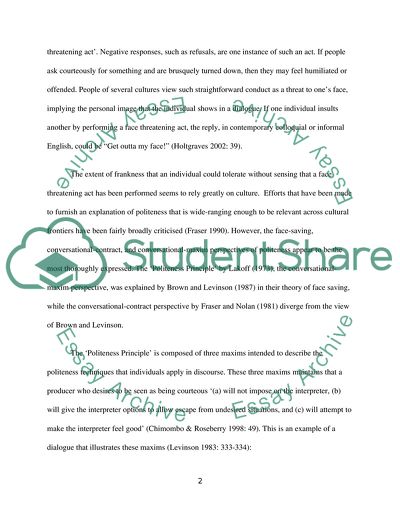Cite this document
(“Politeness in Discourse Analysis Essay Example | Topics and Well Written Essays - 3000 words”, n.d.)
Politeness in Discourse Analysis Essay Example | Topics and Well Written Essays - 3000 words. Retrieved from https://studentshare.org/social-science/1559711-what-is-meant-by-politeness-in-discoursecritically-discuss-and-illustarte-the-various-aspects-and-highlight-potential-problems-please-illustrate-your-answer-with-reference-to-the-sample-transcript-provided-andor-any-other-example-of-spoken-discourse
Politeness in Discourse Analysis Essay Example | Topics and Well Written Essays - 3000 words. Retrieved from https://studentshare.org/social-science/1559711-what-is-meant-by-politeness-in-discoursecritically-discuss-and-illustarte-the-various-aspects-and-highlight-potential-problems-please-illustrate-your-answer-with-reference-to-the-sample-transcript-provided-andor-any-other-example-of-spoken-discourse
(Politeness in Discourse Analysis Essay Example | Topics and Well Written Essays - 3000 Words)
Politeness in Discourse Analysis Essay Example | Topics and Well Written Essays - 3000 Words. https://studentshare.org/social-science/1559711-what-is-meant-by-politeness-in-discoursecritically-discuss-and-illustarte-the-various-aspects-and-highlight-potential-problems-please-illustrate-your-answer-with-reference-to-the-sample-transcript-provided-andor-any-other-example-of-spoken-discourse.
Politeness in Discourse Analysis Essay Example | Topics and Well Written Essays - 3000 Words. https://studentshare.org/social-science/1559711-what-is-meant-by-politeness-in-discoursecritically-discuss-and-illustarte-the-various-aspects-and-highlight-potential-problems-please-illustrate-your-answer-with-reference-to-the-sample-transcript-provided-andor-any-other-example-of-spoken-discourse.
“Politeness in Discourse Analysis Essay Example | Topics and Well Written Essays - 3000 Words”, n.d. https://studentshare.org/social-science/1559711-what-is-meant-by-politeness-in-discoursecritically-discuss-and-illustarte-the-various-aspects-and-highlight-potential-problems-please-illustrate-your-answer-with-reference-to-the-sample-transcript-provided-andor-any-other-example-of-spoken-discourse.


